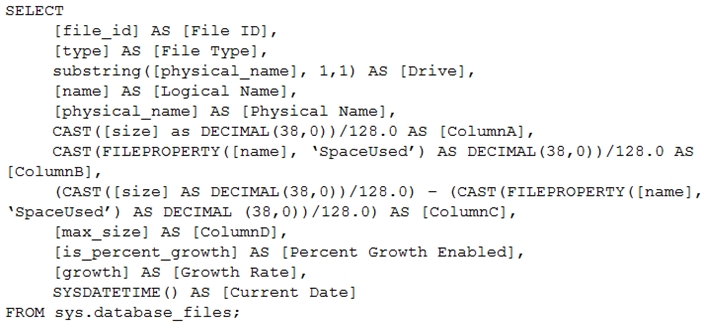Most Recent Microsoft DP-300 Exam Dumps
Prepare for the Microsoft Administering Microsoft Azure SQL Solutions exam with our extensive collection of questions and answers. These practice Q&A are updated according to the latest syllabus, providing you with the tools needed to review and test your knowledge.
QA4Exam focus on the latest syllabus and exam objectives, our practice Q&A are designed to help you identify key topics and solidify your understanding. By focusing on the core curriculum, These Questions & Answers helps you cover all the essential topics, ensuring you're well-prepared for every section of the exam. Each question comes with a detailed explanation, offering valuable insights and helping you to learn from your mistakes. Whether you're looking to assess your progress or dive deeper into complex topics, our updated Q&A will provide the support you need to confidently approach the Microsoft DP-300 exam and achieve success.
The questions for DP-300 were last updated on May 3, 2025.
- Viewing page 1 out of 68 pages.
- Viewing questions 1-5 out of 341 questions
You are building a database backup solution for a SQL Server database hosted on an Azure virtual machine.
In the event of an Azure regional outage, you need to be able to restore the database backups. The solution must minimize costs.
Which type of storage accounts should you use for the backups?
Geo-redundant storage (with GRS or GZRS) replicates your data to another physical location in the secondary region to protect against regional outages. However, that data is available to be read only if the customer or Microsoft initiates a failover from the primary to secondary region. When you enable read access to the secondary region, your data is available to be read if the primary region becomes unavailable. For read access to the secondary region, enable read-access geo-redundant storage (RA-GRS) or read-access geo-zone-redundant storage (RA-GZRS).
Incorrect Answers:
A: Locally redundant storage (LRS) copies your data synchronously three times within a single physical location in the primary region. LRS is the least expensive replication option, but is not recommended for applications requiring high availability.
C: Zone-redundant storage (ZRS) copies your data synchronously across three Azure availability zones in the primary region.
D: Geo-redundant storage (with GRS or GZRS) replicates your data to another physical location in the secondary region to protect against regional outages. However, that data is available to be read only if the customer or Microsoft initiates a failover from the primary to secondary region.
https://docs.microsoft.com/en-us/azure/storage/common/storage-redundancy
You have the following Transact-SQL query.

Which column returned by the query represents the free space in each file?
Example:
Free space for the file in the below query result set will be returned by the FreeSpaceMB column.
SELECT DB_NAME() AS DbName,
name AS FileName,
type_desc,
size/128.0 AS CurrentSizeMB,
size/128.0 - CAST(FILEPROPERTY(name, 'SpaceUsed') AS INT)/128.0 AS FreeSpaceMB
FROM sys.database_files
WHERE type IN (0,1);
https://www.sqlshack.com/how-to-determine-free-space-and-file-size-for-sql-server-databases/
You are planning disaster recovery for the failover group of an Azure SQL Database managed instance.
Your company's SLA requires that the database in the failover group become available as quickly as possible if a major outage occurs.
You set the Read/Write failover policy to Automatic.
What are two results of the configuration? Each correct answer presents a complete solution.
NOTE: Each correct selection is worth one point.
A: Auto-failover groups allow you to manage replication and failover of a group of databases on a server or all
databases in a managed instance to another region.
E: Because verification of the scale of the outage and how quickly it can be mitigated involves human actions
by the operations team, the grace period cannot be set below one hour. This limitation applies to all databases
in the failover group regardless of their data synchronization state.
Incorrect Answers:
C: individual SQL Managed Instance databases cannot be added to or removed from a failover group.
https://docs.microsoft.com/en-us/azure/azure-sql/database/auto-failover-group-overview
You have SQL Server on an Azure virtual machine that contains a database named DB1. DB1 contains a table
named CustomerPII.
You need to record whenever users query the CustomerPII table.
Which two options should you enable? Each correct answer presents part of the solution.
NOTE: Each correct selection is worth one point.
An auditing policy can be defined for a specific database or as a default server policy in Azure (which hosts SQL Database or Azure Synapse):
A server policy applies to all existing and newly created databases on the server.
If server auditing is enabled, it always applies to the database. The database will be audited, regardless of the database auditing settings.
Enabling auditing on the database, in addition to enabling it on the server, does not override or change any of the settings of the server auditing. Both audits will exist side by side.
Note:
The Server Audit Specification object belongs to an audit.
A Database Audit Specification defines which Audit Action Groups will be audited for the specific database in which the specification is created.
https://docs.microsoft.com/en-us/azure/azure-sql/database/auditing-overview
You have two on-premises Microsoft SQL Server 2019 instances named SQL1 and SQL2.
You need to migrate the databases hosted on SQL 1 to Azure. The solution must meet the following requirements:
The service that hosts the migrated databases must be able to communicate with SQL2 by using linked server connections.
Administrative effort must be minimized.
What should you use to host the databases?
Unlock All Questions for Microsoft DP-300 Exam
Full Exam Access, Actual Exam Questions, Validated Answers, Anytime Anywhere, No Download Limits, No Practice Limits
Get All 341 Questions & Answers